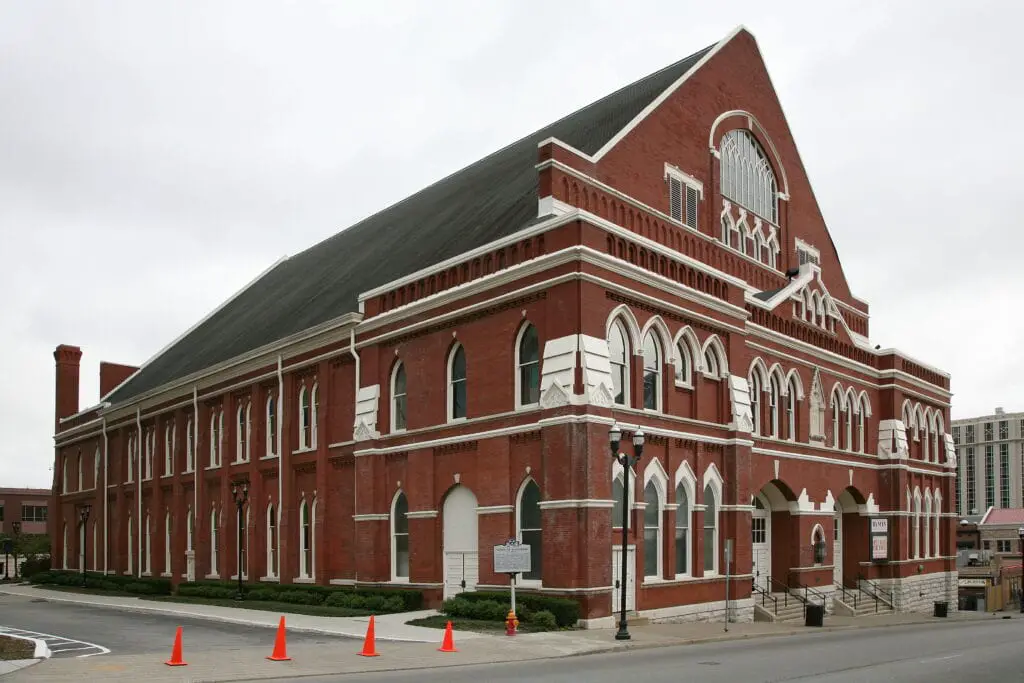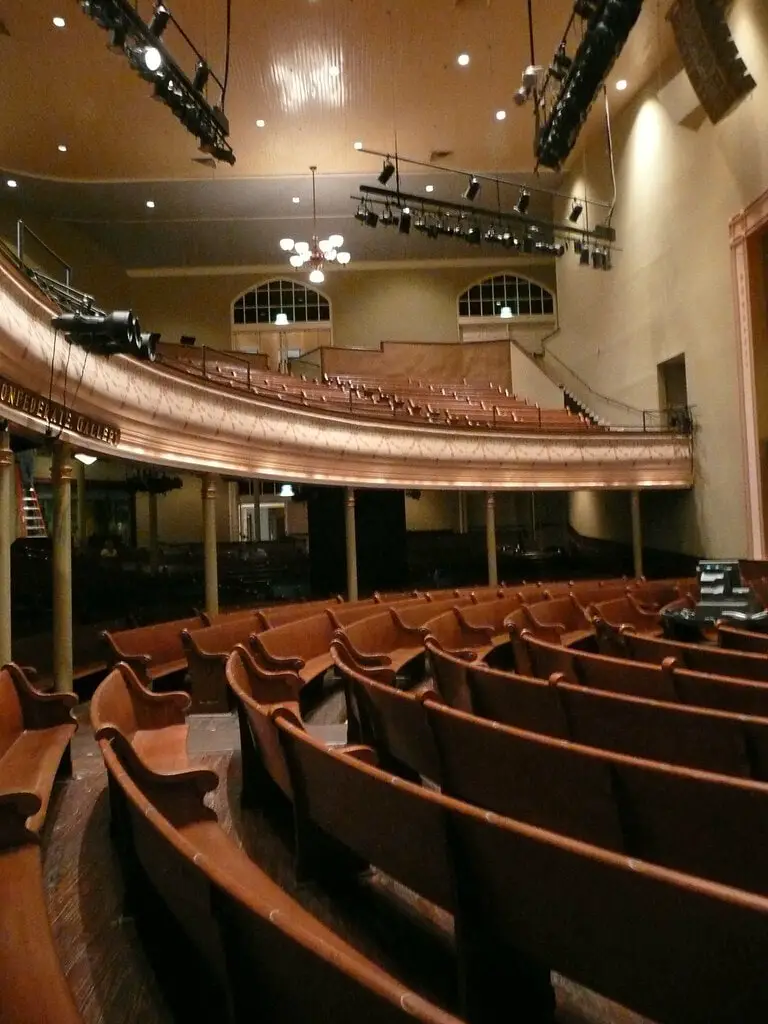The Historical Genesis of Ryman Auditorium
In the heart of Nashville, Tennessee, stands the Ryman Auditorium, a beacon of musical heritage. This iconic venue began its journey as the Union Gospel Tabernacle in 1892, a dream realized by local businessman Thomas Ryman.
Ryman, known for his riverboat enterprises, experienced a life-changing moment at a tent revival led by Samuel Porter Jones. This event transformed him from a skeptic to a devout Christian, inspiring the construction of a grand tabernacle for the people of Nashville.
The building process spanned seven years and cost a staggering $100,000, a hefty sum for the time. Architect Hugh Cathcart Thompson brought Ryman’s vision to life, creating a structure that exceeded its initial budget but stood as a testament to faith and community. Despite financial hurdles, the Tabernacle opened its doors, initially welcoming thousands to spiritual gatherings and revivals.
As years passed, the purpose of the building evolved. The Ryman Auditorium, as it was renamed posthumously in honor of Thomas Ryman, became a cultural landmark.
It hosted various events, from lectures and concerts to political rallies, enriching Nashville’s cultural tapestry. The venue’s transformation from a house of worship to a cornerstone of entertainment marked a significant chapter in its history.
The Ryman’s architectural significance and cultural impact led to its designation as a National Historic Landmark in 2001. This recognition underscored its role in shaping the musical landscape of Nashville and the nation.
Ryman’s story is a testament to the power of vision, faith, and music, intertwining to create a legacy that continues to resonate through the ages.
In exploring things to do in Nashville, Tennessee, a visit to the Ryman Auditorium emerges as a journey through time, reflecting the city’s soul and its people’s spirit.
Lula C. Naff: The Trailblazing Manager
Lula C. Naff, a figure often overlooked in the annals of music history, reshaped the Ryman Auditorium’s destiny.
Starting as a stenographer in the early 1900s, Naff’s journey to becoming the Ryman’s de facto manager is a story of resilience and vision.
In 1914, when her employer faced financial ruin, Naff seized the opportunity to book and promote events at the Ryman full-time. Her knack for business and boldness in a male-dominated industry set her apart.
Naff’s era saw the Ryman transition from a religious venue to Nashville’s premier cultural center. She brought in a diverse array of events, from opera to boxing matches, breaking the mold of traditional programming.
Her efforts paid off, turning the Ryman into a bustling hub that attracted figures like Harry Houdini and Charlie Chaplin in the 1920s and 1930s.
Naff’s tenure wasn’t just about entertainment; it was a cultural mission, elevating Nashville’s status nationwide.
Under Naff’s guidance, the Ryman became known as the “Carnegie Hall of the South,” a title that spoke volumes about prestige.
Her battles against censorship, especially her landmark lawsuit win in 1939, underscored her commitment to artistic freedom.
Naff’s legacy is not just in the shows she booked but in the barriers she broke, paving the way for future generations in the entertainment industry.

The Grand Ole Opry Era
The Grand Ole Opry’s arrival at the Ryman Auditorium in 1943 marked a new chapter for the venue. This cultural phenomenon would define the Ryman and Nashville for decades.
The Opry brought country music to the masses, with legends like Hank Williams, Patsy Cline, and Johnny Cash gracing the stage. Their performances at the Ryman were historic events that fans still talk about today.
The Opry era was a time of growth and challenge. The Ryman’s wooden pews and lack of modern amenities added to its charm and presented logistical issues.
Despite these challenges, every show sold out, a testament to the Opry’s magnetic pull. The Ryman became synonymous with country music, earning the nickname “The Mother Church of Country Music.”
This period wasn’t without its controversies. The Opry’s move from the Ryman in 1974 was met with mixed emotions. While some saw it as a necessary step towards modernization, others felt a profound loss.
The Ryman’s pews had hosted generations of music fans, and its stage had seen the rise of country music’s biggest stars. The end of the Opry era was an end of an era for the Ryman, but not the end of its story.
Facing Demolition and the Fight for Preservation
The Ryman Auditorium faced its darkest hour in the 1970s. News broke out that the beloved venue, steeped in history and memories, was on the brink of demolition.
The thought of losing such a landmark sent shockwaves through Nashville and the music community.
The plan was to replace the Ryman with a more modern facility, stripping away a piece of music history. This decision didn’t sit well with many, sparking a fierce battle for preservation.
The outcry was loud and passionate. Musicians, fans, and historians rallied together, united by a common goal: to save the Ryman.
It was about honoring the legacy of the countless artists who had performed there. The fight for the Ryman symbolized the broader struggle to preserve cultural heritage.
The preservationists’ efforts paid off. The Ryman was spared from the wrecking ball, a victory for history and music lovers alike.
This moment in Ryman’s history was a turning point, highlighting the importance of preserving our cultural landmarks and reminding us that some things are worth fighting for.

Dormancy and Revival
Following the preservation victory, the Ryman Auditorium entered a period of dormancy. The once-bustling venue fell silent, its doors closed to the performances that had defined it for decades.
The surrounding neighborhood, too, felt the impact, with the vibrancy of the past giving way to quiet streets. It was a sad time, reflecting the uncertainty surrounding the Ryman’s future.
But the story didn’t end there. In the late 1980s, a spark of hope emerged. A series of concerts by Emmylou Harris and the Nash Ramblers breathed new life into the dormant venue.
These performances weren’t just concerts but a call to action, reigniting interest in the Ryman’s potential.
The success of these shows proved that the Ryman still had life left in it, catalyzing its revival.
The revival was a comprehensive effort to restore the Ryman to its former glory. Renovations began, aimed at modernizing the venue while preserving its historic charm.
The Ryman’s comeback was a testament to the power of community and the enduring appeal of live music.
It began a new chapter, where the Ryman again stood as a beacon of Nashville’s musical heritage.
The Ryman Auditorium Today
Today, the Ryman Auditorium stands proudly in the heart of Nashville, a symbol of resilience and rebirth.
After extensive renovations, the venue has retained its historic charm and embraced modernity, offering state-of-the-art facilities for artists and audiences.
The Ryman’s calendar is packed with diverse performances, from country legends to contemporary bands, showcasing its commitment to being a music venue for all.

The Ryman’s transformation has also sparked a revival in the surrounding area. New shops, restaurants, and attractions have sprung up, making the neighborhood a vibrant hub of activity once again.
The Ryman’s resurgence has contributed significantly to Nashville’s reputation as a global music city. It’s a place where history is cherished, and new memories are continuously forged.
The auditorium’s impact extends beyond entertainment; it’s a community gathering place, a site for educational tours, and a must-visit for tourists worldwide.
Ryman’s story of revival is a testament to the power of community support and the enduring value of preserving our cultural landmarks.
The Cultural Impact and Legacy
Reflecting on the Ryman Auditorium’s journey, I see its undeniable cultural impact. This venue has witnessed the evolution of American music, hosting genres from gospel and bluegrass to rock and pop. It’s where legends were made and history was written.
The Ryman is more than a building; it’s a living museum, echoing the sounds of past generations while inspiring the current and future ones.
The Ryman Auditorium’s legacy is woven into the fabric of American music history. It has served as a stage for pivotal moments in music, from the birth of bluegrass to significant milestones in the careers of music royalty.
The Ryman’s influence extends beyond its walls, contributing to Nashville’s Music City, USA identity.
The Ryman’s legacy continues to evolve as we look to the future. It remains a beacon for artists and fans, where music is revered, and history is alive.
The Ryman Auditorium is a testament to the enduring power of music and the importance of preserving our cultural heritage for future generations.
